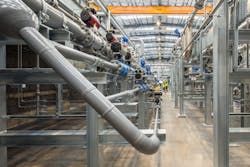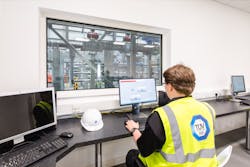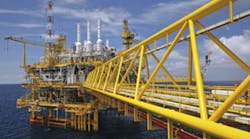Despite the push for greener energy and continuing concerns over the climate, oil and gas still play a vital role in our world, accounting for over half of our total energy consumption as well as being worth in excess of $3,000 billion per year to the global economy. However, as the industry ages and larger production wells dwindle, operators are looking to exploit wells that are smaller, more numerous, more remote and in deeper waters.
This operational shift requires massive reductions in production costs to maintain economic viability. A single, large oil field will typically have its own production facility, where production fluids — gas, oil and produced water — are piped in, separated and metered individually (single-phase) before being transported to a processing facility. This cumbersome and costly process can be almost entirely replaced by a multiphase flowmeter.
Multiphase flowmeters (MPFMs) can be used to measure the flow rate of individual fluid components without the need for separation. Such meters are usually an amalgamation of several measurement technologies, typically using what is conventionally a single-phase device, such as a Venturi, for bulk flow measurement, coupled with a means of characterizing the flow stream composition. Common methods include gamma ray densitometry, tomography or electrical properties measurement such as conductivity or permittivity.
Multiple MPFMs can be installed on multiple wells or small fields, including subsea, tying back to a single topside facility. This model is significantly more cost effective in terms of both operational and capital expenditure. However, cost-saving is not the only benefit to using MPFMs. With new wells further offshore in deeper waters and at much higher pressure, it is far safer to forego a manned platform and reduce the number of personnel required for operation. Without the production platform, flaring operations are also minimized, the overall system pressure drop is massively reduced, less energy is required to pump through pipelines and the carbon footprint is reduced.
In large-field production, several wells may produce to a common separator with the resulting single-phase streams commingled into a common transport pipeline with streams from other separators or facilities. Total flow rates are measured downstream, meaning the contribution from individual wells is not known. Flow rates from individual wells are obtained using a test separator, an isolated small-scale production system, running parallel to the main separator.
Periodically, individual well streams are diverted to the test separator with flow rate measurements taken. These measurements are used for custody transfer and fiscal metering and are attributed to that well until the next test. This method of allocation can be high cost, disruptive to production and subject to user error and inaccuracies. Should there be changes in production volumes or fluid properties, these will not be noticed and rectified until the next well test.
Multiphase flowmeters, however, can continuously measure flow rates for allocation purposes while providing masses of real-time data, which can be viewed remotely, to define well characteristics and fluid properties while eliminating the need for a test separator. Nevertheless, thousands of wells still rely on test separators for well testing in the absence of low-cost, accurate and traceable MPFMs.
Measurement uncertainty and traceability are the major contributing factors for the slow uptake in multiphase metering technologies. After decades of extensive research and development, it is relatively simple to obtain expanded uncertainties of less than 0.5% with single-phase flows under field conditions using the appropriate meter, but this is not the case for MPFMs. Multiphase flow is substantially more complex than single-phase and not just because of the difficulty of measuring multiple flowing fluids simultaneously. In single-phase flow, metrology engineers aim to ensure that the flow profile is well developed at the point of measurement, with well characterized fluid properties and sufficiently high Reynolds number to ensure fully turbulent flow. Meeting these requirements allows for the highest possible measurement accuracy. The challenges associated with multiphase flow are the flow behavior and phase interactions, which are heavily influenced by a wide range of variables such as:
- Individual flow rates and velocities: Flow patterns are highly dependent on superficial gas and liquid velocities, with unstable flows such as slug or plug having a significant effect on the measurement compared with more homogeneous patterns, such as bubble or mist.
- Relative fluid properties of each phase: Many MPFMs use fluid property measurement to determine phase fractions, such as density, viscosity, conductivity and permittivity, which can vary dramatically throughout the lifetime of a well. Oil velocity is massively dependent on viscosity; thus, this also contributes to the resulting flow pattern.
- Pipework geometry and orientation: Well-developed flow profiles require long lengths of uninterrupted straight pipework upstream, which is rarely the case in the field.
- Contamination: Sediment, such as sand and rust, chemical dosing and other contaminants can cause mismeasurement issues.
Irrespective of these challenges, the benefits offered by multiphase flow measurement are substantial, and as a result, a large amount of energy is being dedicated to developing, testing and improving this technology. There are now several high-profile test facilities dedicated to providing a means to test and calibrate such meters in an environment representative of field conditions.
MPFM technology can only be implemented if it has the confidence of operators and regulators. Traceability is the vital aspect in building confidence in such systems, so there must be a clear global reference system for multiphase flow.
To obtain the best possible reference for an MPFM, and due to the lack of accurate reference multiphase meters, reference flow measurements for multiphase flow are taken in the single-phase streams, which are then commingled downstream before entering the meter. Combining this with pressure and temperature instruments (located as close to the meter as practicable), fluid properties (which are usually deduced offline from samples) and a suitable time over which to average the measurements (negating instability such as slugging), it is reasonable to expect expanded uncertainties of less than 1% in both gas and total liquid flow — around one order of magnitude less than most commercially available MPFMs. While most, if not all, international flow laboratories follow this standard methodology, there can be significant variations in the operation and configuration of a specific facility. For example, some facilities may opt to use “live” fluids such as crude oil and natural gas as their test fluids to replicate field conditions, whereas others may opt for refined oil and nitrogen for their well-defined fluid properties and immiscibility.
The main configurative difference between flow laboratories is closed loop versus open loop where the flow loop is either closed to atmosphere or open to it. Each has its own distinct advantages. Closed-loop systems typically allow for much higher pressures, better pressure and temperature control and better flow control. However, open-loop systems are less likely to have contamination at the reference meters (oil-in-water, water-in-oil) and allow for gas local injection systems, where small amounts of gas can be injected into the commingled liquid stream for very low gas volume fraction (GVF) conditions. These significant differences should not affect the facility output — an accurate, traceable reference measurement for multiphase flow.
However, traceability is still a challenge for many laboratories. It is much easier to account for contamination in two-phase liquid flow than with three-phase gas-liquid-liquid flow. With three single-phase streams contributing to a multiphase test point, there are three times as many measurements and thus three times as many traceability chains and uncertainties to consider.
Phase contamination in reference to flow measurements is a major contributor to reference uncertainty and can dramatically affect the measurement if not properly accounted for. Oil-in-water (OIW) and water-in-oil (WIO) contamination are common problems in the field and when trying to obtain single-phase reference measurements in a multiphase facility. Gas dissolution adds another dimension of complexity, especially in pressurized closed-loop systems.
For example, a typical method of deducing OIW or WIO contamination would be using a reference density measurement — or Coriolis flowmeter — in the single-phase stream, with over-reading and under-reading implying WIO or OIW, respectively. Combined with the known fluid properties, it is not difficult to deduce the amount of contamination and account for this.
Dissolved gas, however, is not as easy to account for. Under-reading on water density, for example, could mean gas or oil contamination, with full characterization of a high-pressure sample as the only possible method for confirmation. This adds yet another element of uncertainty to the reference measurement, as sampling is not truly representative of the current flow conditions and can only be used to average the gas dissolution over a given time.
Research and implementation
To build confidence in the global traceability train for multiphase flow and verify individual laboratories’ methodologies, TÜV SÜD National Engineering Laboratory has been involved in two major international intercomparison projects. Funded by EMPIR (European Metrology Programme for Innovation and Research) and conducted in conjunction with several multiphase flow laboratories, industry partners, universities and MPFM manufacturers, the projects involve testing a dedicated MPFM in each of the partner laboratories under the same set of conditions (pressure, temperature and flow rates), evaluating any discrepancies in results and ultimately harmonizing the reference systems used in different facilities. For the benefit of operators and industry in general, these projects aim to provide a robust framework for traceability in multiphase flow metering and advance our understanding of multiphase flow measurement and the factors that influence performance, paving the way for the widespread implementation of this powerful and potentially industry-changing technology.
Aiden White is a section leader for high-pressure multiphase at TÜV SÜD National Engineering Laboratory, a provider of technical consultancy, research, testing and program management services. Part of the TÜV SÜD Group, it is also a global center of excellence for flow measurement and fluid flow systems and is the U.K.’s Designated Institute for Flow Measurement. TÜV SÜD National Engineering Laboratory is a trading name of TUV SUD Ltd, a company of the TÜV SÜD Group. Visit tuv-sud.co.uk/nel.




